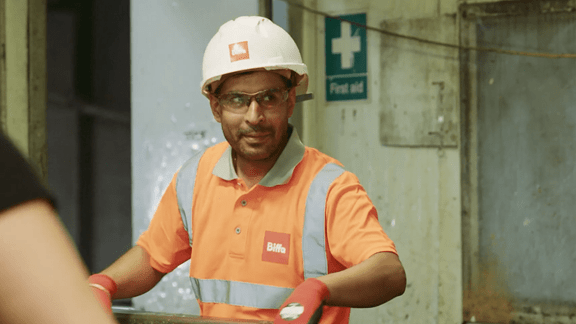
Recycling symbols explained
Recycling is a team effort. When your colleagues and customers put waste in the right bin, you are actively pre-cycling. When you pre-cycle, we can recycle better. Knowing what recycling symbols mean helps us to recycle more together.
If your colleagues and customers can recognise common recycling symbols, it will help us to recycle more. Confusion over the symbols on packaging causes contamination, this can lead to items that could have been recycled into new products being wasted. This leads to more virgin materials being produced which increases the risk to the environment and creates more emissions. Sharing this information with the right people will help you waste less and save more.
Our helpful guide reveals On-Pack Recycling Labels (OPRL) you’re likely to see on the packaging of products in your business. Look closely as some have subtle differences! The UK government has committed to creating a simplified labelling system and we are fully supportive of this.
Not all symbols mean an item is recyclable – and some packaging won’t have a recycling label but can still be recycled. Share with your colleagues and customers to raise awareness of sustainability symbols and lower your carbon footprint. If we all commit to taking a little time to check the label, we can make a big difference.

What do the recycling symbols mean?
Three things to know about pre-cycling at work
On the surface, pre-cycling seems simple. You take a container, you check the label, you make sure it’s empty, then drop it into the right bin. In reality, it’s not always that simple. When we’re at home, we can do it at our own pace, in our own environment, using a routine we have developed ourselves. However out and about at public events, or in the workplace, it is more complicated.
Disposing of rubbish is an automatic behaviour. This means we don’t give it much thought; it’s a reflex. When pre-cycling properly, there are a series of smaller decisions that need to be made to do it correctly. We need to empty the container, rinse out any residue, and remove non-recyclable parts to the packaging. It needs conscious thought. This creates more complexity and more of risk of making a mistake.
This added complexity is ok if it occurs in a controlled environment such as our home. When we need to make choices while focused on work tasks or in public situations, there is more pressure on the decision. There are things you can try in your business to create more space and time for people to make informed choices when it comes to managing waste sustainably and taking part in the circular economy.
Here are three key points to communicate to promote pre-cycling in your business:
1. Pre-cycling helps recycling
Pre-cycling is essential. When businesses pre-cycle it improves the quality of materials, making recycling better. This means less is wasted and less resources are used processing the recycling. We can produce better quality materials to make new products. In many cases this means less carbon emissions are produced, supporting the fight against climate change.
Pre-cycling helps the recycling process, but it can also save you money. When you separate different types of waste, you are actively pre-cycling. For example, a business putting food waste into the General Waste bin will often experience a saving by adding a food waste collection service to their waste management. This reduces the overall weight of the bin and can reduce costs. It diverts food waste from landfill which is a contributor to climate change.
Pre-cycle in 4 simple steps:
- Check: look for symbols on the packaging
- Separate: remove non-recyclable materials
- Clean: rinse or wipe away residue
- Choose: drop the container in the right recycling bin
2. Waste has value
Waste is not perceived to have much value, but it does. A single empty HDPE plastic milk bottle isn’t worth much on its own but combined with all the milk bottles in the closed loop system, it has value to everyone. It has a cash commodity value, it protects our environment and our bodies from plastic pollution, and most importantly, it reduces emissions from having to produce virgin plastic to replace it.
Every time you pre-cycle an item within your business recycling, you are creating value. It won’t all track to your bottom line, but the challenges we face together stretch beyond balance sheets. Helping your colleagues and customers understand pre-cycling and how they can get involved makes a big difference. Taking the time to separate types of packaging and clean waste delivers a return for your community and environment.
We have experts fighting contamination every day...
3. Everyone plays a part
People need time, space, and the right information to make informed choices. Physically you can group bins together, provide clear signage and bin stickers, and audit the materials to monitor the accuracy and quality of recyclables. This can identify common mistakes which can be addressed through further information and support around business recycling.
To nurture a pre-cycling culture, you need to involve everyone. Ringfence a specific time each week when everyone can get involved, have a dedicated pre-cycling advocate, post helpful materials in communal areas or online, communicate and incentivise the quality of waste using metrics like contamination rates.
Knowing recycling symbols is a helpful tool to support pre-cycling, download our guide ‘What do recycling symbols mean?’ and share with your colleagues and customers.

